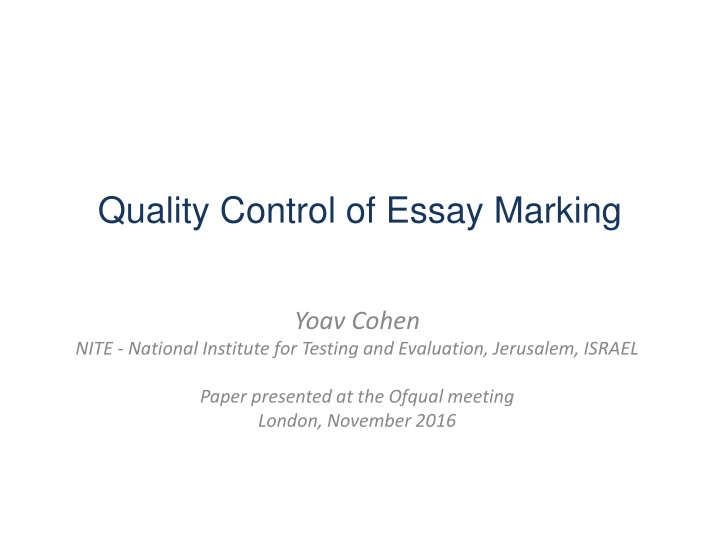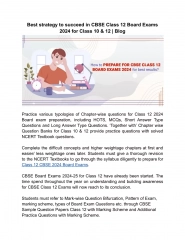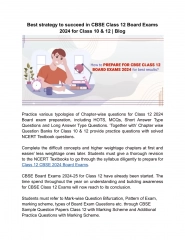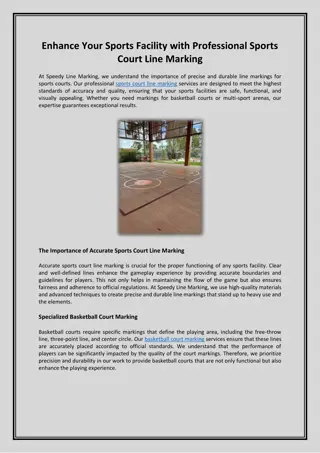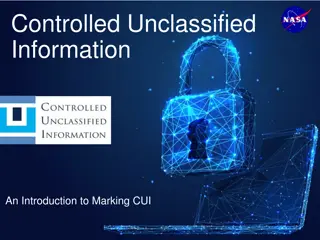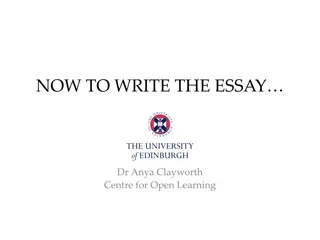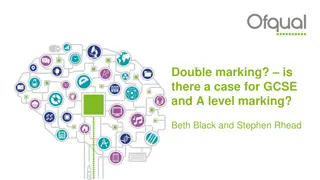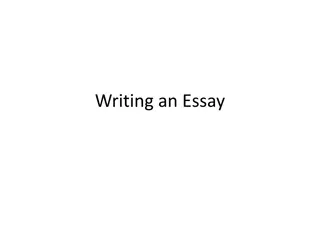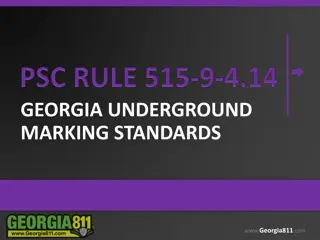Ensuring Quality in Essay Marking Process: Practical Strategies
Ensuring quality in the essay marking process involves various factors such as proactive quality assurance, training markers effectively, managing underperforming markers, and addressing bias and reliability issues. Strategies include deciding markers and items per paper, choosing horizontal or vertical marking, providing feedback, and implementing arbitration processes. Maintaining reliability through intra-rater correlations is crucial for accurate marking.
Download Presentation

Please find below an Image/Link to download the presentation.
The content on the website is provided AS IS for your information and personal use only. It may not be sold, licensed, or shared on other websites without obtaining consent from the author.If you encounter any issues during the download, it is possible that the publisher has removed the file from their server.
You are allowed to download the files provided on this website for personal or commercial use, subject to the condition that they are used lawfully. All files are the property of their respective owners.
The content on the website is provided AS IS for your information and personal use only. It may not be sold, licensed, or shared on other websites without obtaining consent from the author.
E N D
Presentation Transcript
Quality Control of Essay Marking Yoav Cohen NITE - National Institute for Testing and Evaluation, Jerusalem, ISRAEL Paper presented at the Ofqual meeting London, November 2016
Emma Rees: (senior Lecturer in English at the University of Chester) The Mistery [sic] of Marking: What would James Caan do? THE, June 5th,2014
Marking a paper Is an extremely complicated task: Read the text Decipher words, sentences, mistakes Understand - reference Interpret - meaning Weigh various sources of information Translate into numerical score Decide upon a final mark And all of the above in unfavorable conditions: Repetitious task Serial effects Fatigue
Quality Assurance of Paper Marking Proactive: Decide on the number of markers and the number of items per paper Decide whether horizontal or vertical marking? Train the markers During: Give feedback to markers Remove under-performing markers Retroactive: Arbitration/adjudication Equating/calibrating
Proactive means - 1 Number of markers & number of items: In generalizability studies (Brennan) it was found that adding items is better than adding markers. But, requires more resources.
Proactive means - 2 Horizontal vs vertical marking: Horizontal marking improves overall reliability It also helps in reducing the effect of personal bias. (Allalouf, Klapfer & Fronton, 2008. Comparing Vertical and Horizontal Scoring of Open- Ended Questionnaires, Practical Assessment, Research & Evaluation. 13(8))
Quality assurance during the marking process Underperforming markers: Productivity Bias Too severe or too lenient Too narrow Inter-rater reliability Intra-rater reliability
Estimating intra-rater reliability Either by repeated marking of the same papers or by using the inter-rater correlations: r11= r12r13/ r23 r22= r12r23/ r13 r33= r13r23/ r12 , (Cohen, 2016, Estimating the intra-rater reliability of essay raters , NITE RR-16-05)
Retroactive Quality Assurance: Replacement Procedures Replace one of the original raters by a third rater. Procedures adopted by ETS, GMAC, NITE: Whenever there is a marked gap Replace the odd man out EVR
Extreme Value Replacement (EVR) 6.5 7.5
And the rationale is: if there is disagreement between two raters, then probably one of the raters has erred. Hence, there is a need to replace that rater. We do not know which rater it is, but we can assume that it is the rater who is farthest away from the third rater. A similar logic applies when two counts of a set of objects differ from each other. A third count is then called for and, if it agrees with one of the former counts, then this number is taken as the correct one.
Error of measurement in Classical Test Theory e t + = x = 0 te The Standard error of measurement is the sd of e. The error variance is the variance of e. The error and the true score are independent, therefore the variance of the observed score is the sum of the error variance and the true score variance. t x 2 2 2 = + e Since the errors of two ratings are independent of each other, the error variance of an average of 2 ratings is half of the error variance of each rating; the error variance of the average of three ratings is a third of the error variance of a single error, etc.
The measurement error of the average of two scores: 1 e e+ 2 2 The difference between two scores is: e e 1 2
Simulation study: Assume an error model: Normal distribution Binomial distribution Uniform distribution Sample 3 ratings (rating errors) for 100,000 simulated essays. The mean of the ratings is 0.0, their variance equals the error variance of a single rater. Apply EVR or CVR.
Analysis: We now have 100,000 triads of ratings (1st, 2nd and 3rd) For each triad calculate D - the difference between the 1stand 2ndrating. Sort the triads by D, and apply the replacement procedure. Now we can examine the error measurement for the average of the two final ratings in each triad, and calculate its mean for successive groups of 10,000 triads.
The MSE for the top 10% and the next 10% of the essays with the largest gap between them (inter-rater correlation =0.60) MSE of: Top 10% Next 10% Two raters 0.20 0.20 Following EVR 0.45 0.32 Following CVR 0.25 0.20
The effect of replacement on the MSE as a function of the inter-rater gap Normal distribution, n=100,000, r=0.60 MSE 0.5 NR 0.4 0.3 EVR 0.2 CVR 0.1 0 2 4 6 8 10 Decile of inter-rater gap
Interim conclusions EVR increases the error of measurement! [CVR is preferable] Similar results obtain for other error distributions
The Third Rater Fallacy The (wrong) belief that Extreme Value Replacement reduces the error of measurement in case of large inter-rater gap. This wrong belief leads us to invest resources (third rater) for increasing the error of measurement
Similar results obtain when the 3rdrater is an expert rater whose ratings are more accurate.
A caveat: EVR can increase reliability (reduce the error of measurement) when the error distribution is extremely platykurtic.
To what extent is reality represented by the simulation? What happens in the real world? What is the shape of the error distribution? Do all raters have the same error distribution? The problem: In the real world we only have information about the observed score. We do not know what the true score is, hence, we do not know what the error component in each score is.
The answer: According to CTT, the true score is the expected value of the observed scores. The mean of a large number of repeated measurements approximates the true score. As Guilford (1965) expressed it: The true measure is the mean value we should obtain for the object if we measured it a large number of times. If we can get a true score , then we can estimate the error associated with each observed score. And that s what we did .
The study 500 essays written by university candidates for the writing section of the PET The written essays were randomly divided into two groups of 250 essays each Each set of essays was rated by a group of 15 (14) raters working independently The final rating given by a rater to an essay is the sum of two intermediate ratings on a scale of 1 to 6. Therefore the final rating for each rater is on a scale of 2 to 12.
The distribution of all ratings: N=7,250, m=6.9, sd=2.04
Distribution of Rating errors Mean of 0, SD of 1.54 The density histogram of 7,250 rating errors in intervals of 0.5 score-points, together with its smooth approximation (blue) and the corresponding Normal Density function (red).
Analysis There are 14 or 15 ratings per essay From these we can select two ratings designated the first and second ratings (there are 91 or 105 ways to do this for each essay), and then 12 or 13 ways to select a third rating The mean of the remaining 11 (12) ratings serves as the estimate of the true score of the essay Now we can calculate D - the inter-rater gap, and also the measurement error before and after application of the replacement procedure (EVR or CVR) D True score 1 2 3 t t t t t t t t t t t
t t t t t t t t t t t t 15 This procedure can be applied = 13 1365 2 times to each essay in the first set of 250 and 1092 12 2 14 = times to each essay in the second set of 250
Averaged across all essays: 1 EVR CVR 2 3
EVR CVR The simulation results fit well the empirical results ! 2 EVR CVR 2
The marking errors Are indeed normally distributed, within each rater! and hence: also across raters!
Implications for our practice: The replacement procedure is wrong! Testing agencies spend money on increasing the error of measurement. If we want to add a third rater then this should be done whenever the inter-rater difference is small! (Do not estimate reliability of ratings either before or following replacement on the basis of inter-rater correlations!)
Explaining the conundrum: When two ratings are similar, the underlying errors of measurement are probably in the same direction both negative or both positive; hence, the average of the two ratings errs in the same direction. When the two ratings are discrepant, the underlying errors probably have opposite signs, and therefore they compensate each other.
Retroactive Quality Assurance: Calibration of markers Raters are not all equal Some are more consistent than others Some are more lenient than others Some use center grades, others use the full scale (And there are other tendencies/biases: Halo effect Order effects Gender/race bias )
true even after they have undergone a long training period. reflected in the final numerical ratings. Acceptable in classroom assessment. Acceptable in a panel review. But not acceptable in standardized/objective assessment programs.
Calibration Fairness Within the context of high-stakes testing, where many raters score essays, the diversity among the raters has to be minimized in order to report fair and accurate essay scores. One way to achieve this is by numerical adjustment of the scores given by different raters, a process which is usually referred to as score calibration . (interchangeable with rater calibration )
Goal of the current study: To compare the accuracy of several methods for calibrating essay raters. Many raters; two raters per essay. Hence: any two examinees are not necessarily rated by the same raters All the methods are of the linear calibration type, i.e., they adjust the scales of the raters (mean and sd) By computer simulation Under different schemes of allocating essays to raters
General plan Linear calibration methods Allocation schemes Method (simulation) Results & Recommendations
Mean/SD calibration Mean/Sigma method Standardize all raters. (Assumption: the allocation of essays to raters is random).
Calibration by an external criterion Assume that there exists a reliable external criterion, which is linearly related to the essay ratings. Each rater is scaled separately Use the ratees mean and SD on the external criterion
MLC - Multiple Linear Calibration The idea behind MLC is that the pair calibration of particular rater scales to a global scale can be found by using local calibration functions: the pairwise calibration functions between raters.
